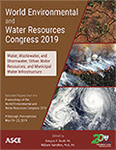World Environmental and Water Resources Congress 2019
Novel Technologies for Concentrate Management
Publication: World Environmental and Water Resources Congress 2019: Water, Wastewater, and Stormwater; Urban Water Resources; and Municipal Water Infrastructure
ABSTRACT
Membrane processes have been adopted by water treatment industries and utilities. The management of concentrate from desalination plants is a challenge due to relatively high levels of both organic and inorganic contaminants. Because of the increasing concern over environmental impacts of concentrates from desalination processes and regulations of pollution control, concentrate management has been shifting towards minimizing the concentrate quantity, potential recovery of materials from concentrate, and improving the concentrate quality. Concentrate quality from different plants could be significantly different in terms of types and levels of compounds present. The removal efficiencies of membrane processes for with low molecular weight contaminants are low, and most data available for the removal of these types of contaminants indicate variable treatment performance. Even with treatment developments, and developments in membrane processes; the concentrate characteristics could be variable. In addition to development of treatment processes for unregulated emerging organic compounds, chemicals used for cleaning may also affect the contaminant-removal efficiency. Types of membrane modules used may affect removal efficiency, which subsequently affects the quality of the concentrates. This paper reviews the treatment options for concentrates from desalination plants for development of integrated water management strategies, to reduce the quantity of concentrates, and for materials recovery.
Get full access to this article
View all available purchase options and get full access to this chapter.
REFERENCES
Ahmed, M., Arakel, A., Hoey, D. (2003). Feasibility of salt production from inland RO desalination plant reject brine: a case study, Desalination 158, 109–117.
Catalyx. (2008). Wyoming Coal Bed Methane Produced Water Treatment, Catalyx Fluid Solutions, Inc.,
Chao, Y.-M., Liang, T.M. (2008). A feasibility study of industrial wastewater recovery using electrodialysis reversal, Desalination, 221, 433-439.
CSM. (2009). Colorido School of Mines. An Integrated Framework for Treatment and Management of Produced Water. RPSEA Project 07122-12.
Dahm, K., Daniels, J., McPherson, D., Witherall, A. (2012). Oxnard Saline Treatment Wetland Monitoring Plan, Baseline Results and Supplemental Research Topics, Reclamation.
Drake, R.N. (2006). Method for preferentially removing monovalent cations from contaminated water, United States Patent No. 7,368,059 B2.
Gilron, J., Folkman, Y., Savliev, R., Waisman, M., Kedem, O. (2003): WAIV — wind aided intensified evaporation for reduction of desalination brine volume, Desalination, 158, 205-214.
Hamieh, B.M., Beckmann, J. R. (2006). Seawater Desalination Using Dew-Vaporation Technique: Theoretical Development and Design Evolution, Desalination, 195(2), 1-13
Hasan, K.S, Ariyamethee, P, Chantaraaumporn, S, Moongkhumklang, P. (2008). Introduction to vibratory shear enhanced membrane process and its application in starch wastewater recycle, Liquid Purification Engineering International Co.
Hausz, L. (2006). Size Does Matter: Evolution of Counter-Current Ion Exchange for Industrial Water Treatment, Eco-Tec Inc., Ontario, Canada.
Jaffrin, M.Y. (2008). Dynamic shear-enhanced membrane filtration: A review of rotating disks, rotating membranes and vibrating systems, Journal of Membrane Science, 324. 7-25.
Lauchli, A., Grattan, S.R. (2007). Plant growth and development under salinity stress. In Advances in molecular breeding toward drought. M.A. Jenks, P.M. Hasegawa, S.M. Mohan (eds)
Loganathan, P., Naidu, G., Vigneswaran, S. (2017). Mining valuable minerals from seawater: a critical Review. Environ. Sci.: Water Res. Technol., 2017, 3, 37–53
Lozier, J., Erdal, U., Lynch, A., Schindler, S. (2007). Evaluating Traditional and Innovative Concentrate Treatment and Disposal Methods for Water Recycling at Big Bear Valley, California. New Logic.
Lozier, J., Ortega, K. (2010). The Oxnard advanced water purification facility: combining indirect potable reuse with reverse osmosis concentrate beneficial use to ensure a California community's water sustainability and provide coastal wetlands restoration, Water. Sci. Technol., 115, 1157-1163.
Mickley, M. (2009). Treatment of Concentrate, U.S. Department of the Interior, Desalination and Water Purification Research and Development Program Report No. 155.
Morillo, J., Usero, J., Rosado, D., ElBakouri, H., Riaza, A., Bernoala, F.J. (2014). Comparative study of brine management technologies for desalination plants. Desalination, 336, 32–49
Shamia, H., Alexander, T., Gurian, P. (2008). Innovative Brine Disposal Options, Drexel University.
Sheedy, M. (2006). Short bed ion exchange technology produces ultrapure water without using a mixed bed, Eco-Tec, Ontario, Canada.
Zulkaliph, N.A., Juraimi, A.S., Uddin, K., Ismail, M.R., Hamdani, M.S.A. (2017). Screening of potential salt tolerant turfgrass species in Peninsular Malaysia. Australian Journal of Crop Science 7, (10)1571-1581.
Information & Authors
Information
Published In
World Environmental and Water Resources Congress 2019: Water, Wastewater, and Stormwater; Urban Water Resources; and Municipal Water Infrastructure
Pages: 206 - 210
Editors: Gregory F. Scott and William Hamilton, Ph.D.
ISBN (Online): 978-0-7844-8236-0
Copyright
© 2019 American Society of Civil Engineers.
History
Published online: May 16, 2019
Authors
Metrics & Citations
Metrics
Citations
Download citation
If you have the appropriate software installed, you can download article citation data to the citation manager of your choice. Simply select your manager software from the list below and click Download.
